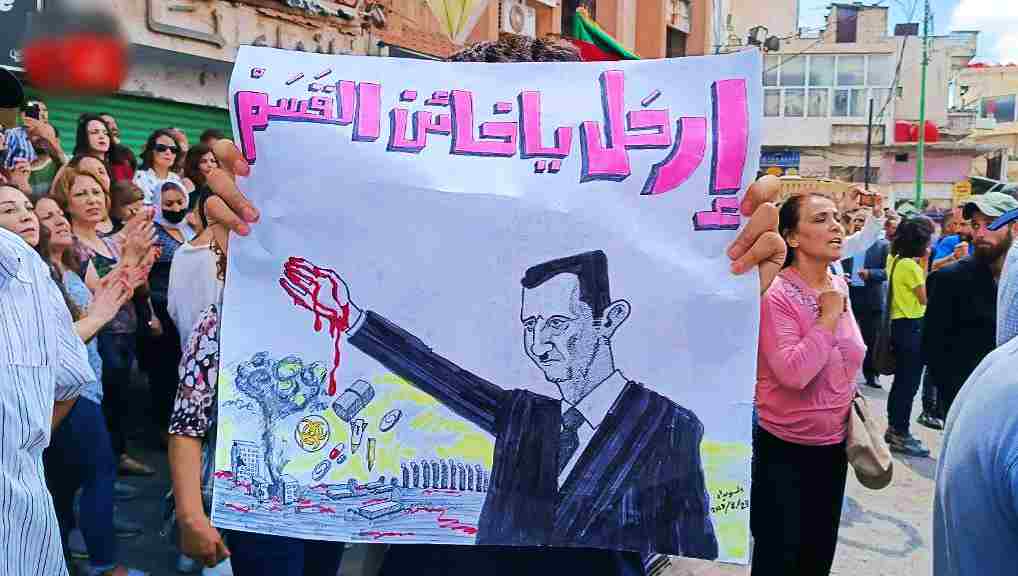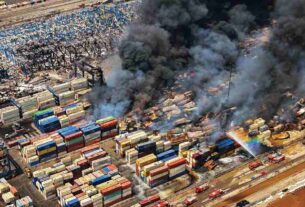Fri 01 September 2023:
For a second week, protesters have come out in Sweida in southwestern Syria to voice their anger at the government, with the Druze flag waving above demonstrators and banners of President Bashar al-Assad being set on fire.
At one point, demonstrators raided several offices belonging to the ruling Baath party in the Druze stronghold, kicking party members out of their offices, welding the doors shut and spray-painting anti-government slogans on the walls.
Here’s all you need to know about the protests in Sweida:
Massive anti-regime protests continue in southern Syria against declining living conditions & Syrian regime's economic policies spread across southern Syria this week. Strike was declared in Suweida province hundreds of protesters chanted slogans against regime. pic.twitter.com/7AvjSCt2HJ
— INDEPENDENT PRESS (@IpIndependent) August 27, 2023
Why are people protesting?
The protests were initially driven by surging inflation and the war-torn country’s worsening economy, but quickly shifted focus, with marchers calling for the fall of the al-Assad government.
Centred in the government-controlled province of Sweida, the heartland of Syria’s Druze who had stayed neutral in the conflict between al-Assad and those opposing him, the protests are unusual.
For some, the final straw came two weeks ago when al-Assad further scaled back the country’s fuel and gasoline subsidy programme.
Public sector wages and pensions, already meagre, were doubled at the same time, but that only accelerated inflation and further weakened the Syrian pound, increasing the pressure on millions living in poverty.
Soon after, protests kicked off in Sweida and the neighbouring province of Deraa, the cradle of the Syrian revolution.
Crowds quickly swelled into the hundreds, decrying repression by al-Assad’s government, an echo of protests that rocked the country in 2011.
"Just when #Syria's Assad thought he was in the clear, a new wave of protests against his rule has broken out in areas under his control, emphatically shattering the image he and his allies have sought to present of a resounding "victor" and only "hope"+"guarantor" of stability" pic.twitter.com/ddro7YLzhq
— Sami Hamdi سامي الهاشمي الحامدي (@SALHACHIMI) August 28, 2023
Where have the protests spread?
Hundreds of protesters have also gathered in northern Aleppo and Idlib, in the northwest, and Deir Az Zor, Raqqa and Hassakeh in the northeast.
In Damascus, Latakia, Tartous and other urban government strongholds, some are voicing their discontent more quietly.
They write messages of support for the protests on paper, take pictures of those notes on the streets of their towns, and share them on social media.
What is life like for Syrians?
While al-Assad’s political fortunes have been on the rise in recent months, life for much of the country’s population has become increasingly miserable.
At least 300,000 civilians have been killed in the conflict, half of Syria’s pre-war population of 23 million has been displaced and large parts of the infrastructure have been crippled.
Ninety percent of Syrians live in poverty. Rampant corruption and Western-led sanctions have also worsened poverty.
In Damascus, some have taken to carrying backpacks instead of wallets to carry the wads of cash they need to make everyday purchases amid rampant inflation, while families struggle to buy necessities.
“If I buy (my son) two containers of milk, I’d have spent my entire month’s salary,” Damascus resident Ghaswan al-Wadi told the AP while preparing her family dinner at home after a long day at work.
How have authorities responded to the protests?
The protests have rattled the al-Assad government, but don’t seem to pose an existential threat, coming at a time when government forces have consolidated their control over most of the country and Damascus has returned to the Arab fold.
In government-controlled Deraa, at least 57 people have been arrested, according to the United Kingdom-based Syrian Network for Human Rights. Unlike in 2011, government forces did not use lethal force.
In Sweida, the response has been more restrained, with al-Assad apparently wary of exerting too much force against the Druze. During the years of war, his government presented itself as a defender of religious minorities against “Islamist extremism”.
Over the years, the province’s young men have also armed themselves to defend their villages from ISIL (ISIS) fighters and Damascus-associated militias that produce and trade in illegal amphetamine pills, known as Captagon.
Joseph Daher, a Swiss-Syrian researcher and professor at the European University Institute in Florence, believes that this provides a layer of protection for protesters.
“Unlike other government-held areas, Sweida has some form of limited autonomy,” Daher told AP.
Could the protests threaten al-Assad’s rule?
Daher said this could only happen if the protesters banded together.
“You have forms of solidarity from other cities [with Sweida],” Daher said. “But you can’t say it would have a real effect on the regime unless there would be collaboration between (protesters in) different cities.”
SOURCE: AL JAZEERA AND NEWS AGENCIES
______________________________________________________________
FOLLOW INDEPENDENT PRESS:
TWITTER (CLICK HERE)
https://twitter.com/IpIndependent
FACEBOOK (CLICK HERE)
https://web.facebook.com/ipindependent
Think your friends would be interested? Share this story!





